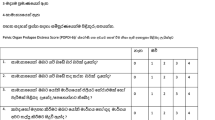Abstract
Introduction and hypothesis
This study adapted the Pelvic Floor Distress Inventory–Short Form 20 (PFDI-20) and the Pelvic Floor Impact Questionnaire-7 (PFIQ-7) into the Tigrigna language of northern Ethiopia and validated the their reliability and validity through patient interviews.
Methods
Expert translation, cognitive interviewing, and patient interviews using translated questionnaires were conducted. A subset of women was reinterviewed 1 week later. Intraclass correlation coefficients (ICC), Bland–Altman analysis, and Cronbach’s alpha values were assessed. Total and subscale scores were compared between women with and without pelvic floor disorders (PFDs) using the Mann–Whitney U test. Spearman’s correlation coefficients were used to compare severity of pelvic organ prolapse (POP) stage according to the POP Quantification (POP-Q) system and PFDI-20 and PFIQ-7 and subscale scores.
Results
Ten women participated in cognitive interviewing and 118 age 49 ± 10 years, mean ± standard deviation (SD) with and without PFDs were interviewed using the translated questionnaires, both of which presented adequate face validity and test–retest reliability [intraclass correlation coefficient (ICC) 0.765–0.969, p < 0.001]. Construct validity was significant between clinical symptoms and full forms (p <0.001) and their subscales (p <0.001), except for the Pelvic Organ Prolapse Impact Questionnaire (POPIQ). Differences between first and second scores on total PFDI-20 and PFIQ-7 and subscales largely fell within 0 ± 1.96 SD. Cronbach’s alpha values were 0.891–0.930 for PFDI-20 and 0.909–0.956 for PFIQ-7 (p < 0.001). Analysis of known groups showed differences PFDI-20 and PFIQ-7 scores between women with and without PFDs (p <0.001 for full forms and subscales, except for anal incontinence (AI) and the Urinary Impact Questionnaire (UIQ)/POPIQ.
Conclusion
The translated Tigrigna versions of the PFDI-20 and PFIQ-7 questionnaires are reliable, valid, and feasible tools to evaluate symptoms and quality of life (QoL) of Tigrigna-speaking Ethiopian women with PFDs.
Similar content being viewed by others
References
Megabiaw B, Adefris M, Rortveit G, Degu G, Muleta M, Blystad A, et al. Pelvic floor disorders among women in Dabat district, northwest Ethiopia: a pilot study. Int Urogynecol J. 2013;24(7):1135–43.
Barber MD, Kuchibhatla MN, Pieper CF, Bump RC. Psychometric evaluation of 2 comprehensive condition-specific quality of life instruments for women with pelvic floor disorders. Am J Obstet Gynecol. 2001;185(6):1388–95.
Barber MD, Walters MD, Bump RC. Short forms of two condition-specific quality-of-life questionnaires for women with pelvic floor disorders (PFDI-20 and PFIQ-7). Am J Obstet Gynecol. 2005;193(1):103–13.
Young AE, Fine PM, McCrery R, Wren PA, Richter HE, Brubaker L, et al. Spanish language translation of pelvic floor disorders instruments. Int Urogynecol J. 2007;18(10):1171–8.
Omotosho TB, Hardart A, Rogers RG, Schaffer JI, Kobak WH, Romero AA. Validation of Spanish versions of the pelvic floor distress inventory (PFDI) and pelvic floor impact questionnaire (PFIQ): a multicenter validation randomized study. Int Urogynecol J. 2009;20(6):623–39.
Sánchez-Sánchez B, Torres-Lacomba M, Yuste-Sánchez MJ, Navarro-Brazález B, Pacheco-da-Costa S, Gutiérrez-Ortega C, et al. Cultural adaptation and validation of the pelvic floor distress inventory short form (PFDI-20) and pelvic floor impact questionnaire short form (PFIQ-7) Spanish versions. Europe J Obstet Gynecol Reprod Biol. 2013;170(1):281–5.
De Tayrac R, Deval B, Fernandez H, Marès P, Institute, M. R. Validation linguistique en français des versions courtes des questionnaires de symptômes (PFDI-20) et de qualité de vie (PFIQ-7) chez les patientes présentant un trouble de la statique pelvienne. Journal de Gynécologie Obstétrique et Biologie de la Reproduction. 2007;36(8):738–48.
Teleman P, Stenzelius K, Iorizzo L, Jakobsson U. Validation of the Swedish short forms of the pelvic floor impact questionnaire (PFIQ-7), pelvic floor distress inventory (PFDI-20) and pelvic organ prolapse/urinary incontinence sexual questionnaire (PISQ-12). Acta Obstet Gynecol Scand. 2011;90(5):483–7.
Zhu L, Yu S, Xu T, Yang X, Lu Y, Li B, et al. Chinese validation of the pelvic floor impact questionnaire short form. Menopause. 2011;18(9):1030–3.
Celenay ST, Akbayrak T, Kaya S, Ekici G, Beksac S. Validity and reliability of the Turkish version of the pelvic floor distress Inventory-20. Int Urogynecol J. 2012;23(8):1123–7.
Kaplan PB, Sut N, Sut HK. Validation, cultural adaptation and responsiveness of two pelvic-floor-specific quality-of-life questionnaires, PFDI-20 and PFIQ-7, in a Turkish population. Europe J Obstet Gynecol Reprod Biol. 2012;162(2):229–33.
Treszezamsky AD, Karp D, Dick-Biascoechea M, Ehsani N, Dancz C, Montoya TI, et al. Spanish translation and validation of four short pelvic floor disorders questionnaires. Int Urogynecol J. 2013;24(4):655–70.
Bland JM, Altman DG. Statistical methods for assessing agreement between two methods of clinical measurement. Lancet. 1986;1(8476):307–10.
Fayers, P. M., & Machin, D. (2007). Principles of measurement scales. Quality of Life: The Assessment, Analysis and Interpretation of Patient-Reported Outcomes, Second edition, 31–48.
Utomo E, Blok BF, Steensma AB, Korfage IJ. Validation of the pelvic floor distress inventory (PFDI-20) and pelvic floor impact questionnaire (PFIQ-7) in a Dutch population. Int Urogynecol J. 2014;25(4):531–44.
Yoshida M, Murayama R, Ota E, Nakata M, Kozuma S, Homma Y. Reliability and validity of the Japanese version of the pelvic floor distress inventory-short form 20. Int Urogynecol J. 2013;24(6):1039–46.
Acknowledgements
The authors are thankful to study participants and Mekelle University College of Health Sciences. They also thank Ken Divelbess, MPA, for assistance editing the manuscript.
Author information
Authors and Affiliations
Corresponding author
Rights and permissions
About this article
Cite this article
Goba, G.K., Legesse, A.Y., Zelelow, Y.B. et al. Reliability and validity of the Tigrigna version of the Pelvic Floor Distress Inventory–Short Form 20 (PFDI-20) and Pelvic Floor Impact Questionnaire-7 (PFIQ-7). Int Urogynecol J 30, 65–70 (2019). https://doi.org/10.1007/s00192-018-3583-9
Received:
Accepted:
Published:
Issue Date:
DOI: https://doi.org/10.1007/s00192-018-3583-9




